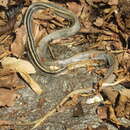en
names in breadcrumbs


Coelognathus radiatus is a large and relatively slender snake that has a wide distribution in southern and Southeast Asia.. The narrow head is slightly set off from the neck. The snout is slightly rounded and approximately twice the length of the eye diameter. The tail is relatively shorter and slender. The ventral keels are fairly well developed. The cross-section of the body is higher than wide. The eyes are relatively large and have a golden-yellow iris. The tongue is brownish-violet. The head is copper or dull orange; a transverse black stripe runs across the head, with black streaks leading to the eyes and two running backwards. Two black stripes are present below the eyes. Three narrow black stripes radiate from the eyes, one directly below the eye, another obliquely to the angle of the mouth, and a third fusing with the narrow collar band on the nape. The body is yellowish-brown, anteriorly adorned with longitudinal black stripes, usually three on each side, the median one not connected to the black collar.
Posteriorly, the stripes disappear. The belly is pale yellow, mottled with grey. The skin is checkered black, blue-gray and bright yellow anteriorly, visible when the snake inflates itself when displaying aggression. Total body length of a specimen collected from the Western Ghats was approximately 2.15m.
Scutellation: Coelognathus radiatus have two postoculars, 2+2 temporals; 1 preocular, 9 supralabials (with 4th, 5th and 6th in contact with the eye; among which the 6th supralabial shield is largest and is arched around and behind the eye); 10 infralabials; 19 dorsals (mid-body), weakly keeled on the back and smooth on the sides; 250 ventral, 106 subcaudals, anal plate undivided.
This species has been recorded from gardens, crop fields adjacent to forest, open areas, and waterlogged areas. It is active both night and day. When threatened, these snakes will often flatten their necks vertically, throwing themselves into an S-shaped loop, opening their mouths and remaining alert, ready to defend themselves vigorously against attack. The black lateral bars that are exposed by this behavior may act as a warning to enemies.
(Maqsood et al. 2010)
Vogel and Han-Yuen (2010) described several incidents of death-feigning (or thanatosis) by Coelognathus radiatus.
Coelognathus radiatus, commonly known as the radiated ratsnake, copperhead rat snake, or copper-headed trinket snake, is a nonvenomous[2][3] species of colubrid snake.
These snakes are usually defensive in nature which makes it hard to catch or control them.[4] [5]
Type locality: Java[7]
Coelognathus radiatus, commonly known as the radiated ratsnake, copperhead rat snake, or copper-headed trinket snake, is a nonvenomous species of colubrid snake.